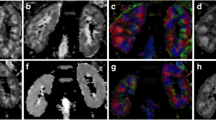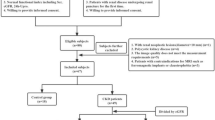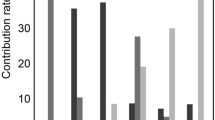Abstract
Objective
This study aimed to investigate the value and feasibility of combining fractional anisotropy (FA) values from diffusion tensor imaging (DTI) and total kidney volume (TKV) for the assessment of kidney function in chronic kidney disease (CKD).
Materials and methods
Fifty-one patients were included in this study. All MRI examinations were performed with a 3.0 T scanner. DTI was used to measure FA values, and TKV was obtained from DTI and T2-weighted imaging (T2WI). Patients were divided into three groups (mild, moderate, severe) according to eGFR, which was calculated with serum creatinine. Differences in the FA values of the cortex and medulla were analysed among the three groups, and the relationships of FA values, TKV, and the product of the FA values and TKV with eGFR were analysed. Receiver operating characteristic (ROC) curve analysis was used to compare the diagnostic efficiency of the FA values, TKV, and the product of the FA values and TKV for kidney function in different CKD stages.
Results
Medullary FA values (m-FA), TKV, and the product of the m-FA values and TKV (m-FA-TKV) were significantly correlated with eGFR (r = 0.653, 0.685, and 0.797, respectively; all P < 0.001). ROC curve analysis showed that m-FA-TKV exhibited better diagnostic performance than m-FA values (P = 0.022).
Conclusion
m-FA-TKV obtained by DTI significantly improves the accuracy of kidney function assessment in CKD patients.





Similar content being viewed by others
References
GBD Chronic Kidney Disease Collaboration (2020) Global, regional, and national burden of chronic kidney disease, 1990–2017: a systematic analysis for the Global Burden of Disease Study 2017. Lancet 395(10225):709–733
Coresh J, Selvin E, Stevens LA, Manzi J, Kusek JW, Eggers P, Van Lente F, Levey AS (2007) Prevalence of chronic kidney disease in the United States. JAMA 298(17):2038–2047
Brown SA, Tyrer FC, Clarke AL, Lloyd-Davies LH, Stein AG, Tarrant C, Burton JO, Smith AC (2017) Symptom burden in patients with chronic kidney disease not requiring renal replacement therapy. Clin Kidney J 10(6):788–796
St Peter WL, Guo H, Kabadi S, Gilbertson DT, Peng Y, Pendergraft T, Li S (2018) Prevalence, treatment patterns, and healthcare resource utilization in Medicare and commercially insured non-dialysis-dependent chronic kidney disease patients with and without anemia in the United States. BMC Nephrol 19(1):67
Mao W, Zhou J, Zeng M, Ding Y, Qu L, Chen C, Ding X, Wang Y, Fu C, Gu F (2018) Intravoxel incoherent motion diffusion-weighted imaging for the assessment of renal fibrosis of chronic kidney disease: a preliminary study. Magn Reson Imaging 47:118–124
Li LP, Tan H, Thacker JM, Li W, Zhou Y, Kohn O, Sprague SM, Prasad PV (2017) Evaluation of renal blood flow in chronic kidney disease using arterial spin labeling perfusion magnetic resonance imaging. Kidney Int Rep 2(1):36–43
Pruijm M, Milani B, Pivin E, Podhajska A, Vogt B, Stuber M, Burnier M (2018) Reduced cortical oxygenation predicts a progressive decline of renal function in patients with chronic kidney disease. Kidney Int 93(4):932–940
Ye XJ, Cui SH, Song JW, Liu K, Huang XY, Wang L, Zhou YJ, Yan ZH, Wang GB (2019) Using magnetic resonance diffusion tensor imaging to evaluate renal function changes in diabetic patients with early-stage chronic kidney disease. Clin Radiol 74(2):116–122
Palmucci S, Mammino L, Caltabiano DC, Costanzo V, Foti PV, Mauro LA, Farina R, Profitta ME, Sinagra N, Ettorre GC, Veroux M, Basile A (2019) Diffusion-MR in kidney transplant recipients: is diuretic stimulation a useful diagnostic tool for improving differentiation between functioning and non-functioning kidneys? Clin Imaging 53:97–104
Kaimori JY, Isaka Y, Hatanaka M, Yamamoto S, Ichimaru N, Fujikawa A, Shibata H, Fujimori A, Miyoshi S, Yokawa T, Kuroda K, Moriyama T, Rakugi H, Takahara S (2017) Diffusion tensor imaging MRI With spin-echo sequence and long-duration measurement for evaluation of renal fibrosis in a rat fibrosis model. Transplant Proc 49(1):145–152
Deger E, Celik A, Dheir H, Turunc V, Yardimci A, Torun M, Cihangiroglu M (2018) Rejection evaluation after renal transplantation using MR diffusion tensor imaging. Acta Radiol 59(7):876–883
Otsuka T, Kaneko Y, Sato Y, Kaseda R, Aoyagi R, Yamamoto S, Goto S, Narita I (2018) Kidney morphological parameters measured using noncontrast-enhanced steady-state free precession MRI with spatially selective inversion recovery pulse correlate with eGFR in patients with advanced CKD. Clin Exp Nephrol 22(1):45–54
Li Q, Wang D, Zhu X, Shen K, Xu F, Chen Y (2018) Combination of renal apparent diffusion coefficient and renal parenchymal volume for better assessment of split renal function in chronic kidney disease. Eur J Radiol 108:194–200
Rutkowski M, Mann W, Derose S, Selevan D, Pascual N, Diesto J, Crooks P (2009) Implementing KDOQI CKD definition and staging guidelines in Southern California Kaiser Permanente. Am J Kidney Dis 53(3 Suppl 3):S86-99
Li Y, Lee MM, Worters PW, MacKenzie JD, Laszik Z, Courtier JL (2017) Pilot study of renal diffusion tensor imaging as a correlate to histopathology in pediatric renal allografts. AJR Am J Roentgenol 208(6):1358–1364
Delgado J, Berman JI, Maya C, Carson RH, Back SJ, Darge K (2019) Pilot study on renal magnetic resonance diffusion tensor imaging: are quantitative diffusion tensor imaging values useful in the evaluation of children with ureteropelvic junction obstruction? Pediatr Radiol 49(2):175–186
Wang YC, Feng Y, Lu CQ, Ju S (2018) Renal fat fraction and diffusion tensor imaging in patients with early-stage diabetic nephropathy. Eur Radiol 28(8):3326–3334
Adibi A, Mortazavi M, Shayganfar A, Kamal S, Azad R, Aalinezhad M (2016) Relationship between renal volume calculated by using multislice computed tomography and glomerular filtration rate calculated by using the Cockcroft–Gault and modification of diet in renal disease equations in living kidney donors. Saudi J Kidney Dis Transpl 27(4):671–676
Lange D, Helck A, Rominger A, Crispin A, Meiser B, Werner J, Fischereder M, Stangl M, Habicht A (2018) Renal volume assessed by magnetic resonance imaging volumetry correlates with renal function in living kidney donors pre- and postdonation: a retrospective cohort study. Transpl Int 31(7):773–780
Liu Z, Xu Y, Zhang J, Zhen J, Wang R, Cai S, Yuan X, Liu Q (2015) Chronic kidney disease: pathological and functional assessment with diffusion tensor imaging at 3T MR. Eur Radiol 25(3):652–660
Christensen RH, Lundgren T, Stenvinkel P, Brismar TB (2017) Renal volumetry with magnetic resonance imaging. Acta Radiol Open 6(9):2058460117731120
Feng YZ, Chen XQ, Yu J, Liu XL, Cheng ZY, Ren WW, Feng L, Cai XR (2018) Intravoxel incoherent motion (IVIM) at 3.0 T: evaluation of early renal function changes in type 2 diabetic patients. Abdom Radiol (NY) 43(10):2764–2773
Bane O, Wagner M, Zhang JL, Dyvorne HA, Orton M, Rusinek H, Taouli B (2016) Assessment of renal function using intravoxel incoherent motion diffusion-weighted imaging and dynamic contrast-enhanced MRI. J Magn Reson Imaging 44(2):317–326
Mao W, Zhou J, Zeng M, Ding Y, Qu L, Chen C, Ding X, Wang Y, Fu C (2018) Chronic kidney disease: Pathological and functional evaluation with intravoxel incoherent motion diffusion-weighted imaging. J Magn Reson Imaging 47(5):1251–1259
Gaudiano C, Clementi V, Corcioni B, Renzulli M, Mancini E, Golfieri R (2020) Diffusion tensor imaging in renal artery stenosis: a preliminary report. Br J Radiol 93(1115):20200101
Funding
This work was supported by The Science and Technology Development Fund Project of Nanjing Medical University (NMUB2019242).
Author information
Authors and Affiliations
Contributions
Conceptualization: X-SL, HZ, Q-JZ, JZ. Methodology: Z-CH, Z-YX, LW. Formal analysis and investigation: X-SL, Q-QZ. Writing—original draft preparation: X-SL. Writing—review and editing: Q-QZ, X-DY. Funding acquisition: X-SL, Y-SY. Supervision: HZ, Y-SY.
Corresponding author
Ethics declarations
Conflict of interest
None.
Ethical approval
This study was performed in line with the principles of the Declaration of Helsinki.
Additional information
Publisher's Note
Springer Nature remains neutral with regard to jurisdictional claims in published maps and institutional affiliations.
Rights and permissions
About this article
Cite this article
Li, XS., Zhang, QJ., Zhu, J. et al. Assessment of kidney function in chronic kidney disease by combining diffusion tensor imaging and total kidney volume. Int Urol Nephrol 54, 385–393 (2022). https://doi.org/10.1007/s11255-021-02886-8
Received:
Accepted:
Published:
Issue Date:
DOI: https://doi.org/10.1007/s11255-021-02886-8




